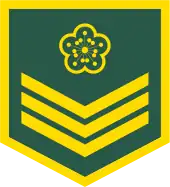Bing (rank)
Bing (Chinese: 兵; Korean: 병; Hanja: 兵) is the rank usually held by enlisted personnel in some East Asian militaries. The ranks are used in both the People's Republic of China and the Republic of China on Taiwan, and both North and South Korea. The rank name is based on the on one of the four ancient occupations.
Etymology
The Sino-Korean word component "byeong" means "soldier" literally, used in a wide variety of words related with soldiers, like in busang-byeong (Korean: 부상병; Hanja: 負傷兵, lit. 'a wounded soldier'), but rarely (usually in technical context in armed forces) per se.
Byeongjangs, who work closely with their US military counterparts, are frequently addressed as "sergeant" or the equivalent E-5 term in English by the U.S. military. This varies however by unit. In a similar vein, some US E-5s are called hasa by the ROKA members, as their status is one of an NCO.
History
The various ranks of byeong are denoted by stripes worn laterally on a service member's left sleeve. An even lower rank, that of mudeungbyeong (Korean: 무등병; Hanja: 無等兵, lit. 'soldier with no rank'), also known as hullyeonbyeong (Korean: 훈련병; Hanja: 訓鍊兵, lit. 'trainee soldier'), is usually believed to be held by enlisted recruits in basic training, and those recruits are not allowed to have any insignia on their uniform until they finish the training course, but they are actually regarded to be ideungbyeong (the lowest byeong rank) officially.
In most comparative military scales, a Byeongjang is considered the equivalent of a non-commissioned officer equal to a sergeant. The South Korean military, however, does not generally grant NCO powers to a service member until obtaining the rank of hasa. Still, Byeongjang in South Korea is exceptionally considered as an NCO when holding the squad leader position.
The word byeong (soldier) has a natural context that personnel in those ranks are not in commanding responsibilities, thus not NCOs at all. They are strictly distinguished from the ranks above in many respects. Personnel with ranks of hasa or above are called ganbu (Korean: 간부; Hanja: 幹部, lit. 'the executive members'), as an antonym of byeong. South Korea's South Korean military are retained by the conscription system. If a person is enlisted to an armed force and has not applied for NCO or officer, then his highest rank until he finishes the mandatory service term (21 months in case of the ROK Army, as of 2012) is to be the highest rank of byeong (i.e. Byeongjang).
Chinese variant
People's Liberation Army
The same rank names are used for all services, prefixed by haijun (simplified Chinese: 海军; traditional Chinese: 海軍; lit. 'naval force') or kongjun (simplified Chinese: 空军; traditional Chinese: 空軍; lit. 'air force').
| Rank group | Enlisted | |
|---|---|---|
| 上等兵 Shàngděngbīng |
列兵 Lièbīng | |
 |
 | |
 |
 | |
 |
 | |
| 上等兵 Shàngděngbīng |
列兵 Lièbīng | |
| Rank group | Enlisted | |
Republic of China Armed Forces
| Rank group | Enlisted | ||
|---|---|---|---|
| 上等兵 Shàngděngbīng |
一等兵 Yīděngbīng |
二等兵 Èrděngbīng | |
 |
 |
 | |
 |
 |
 | |
 |
 |
 | |
 |
 |
 | |
 |
 |
 | |
| 上等兵 Shàngděngbīng |
一等兵 Yīděngbīng |
二等兵 Èrděngbīng | |
| Rank group | Enlisted | ||
Korean variant
| Bing | |
| Hangul | 병 |
|---|---|
| Hanja | 兵 |
| Revised Romanization | Byeong |
| McCune–Reischauer | Pyǒng |
| Rank group | Enlisted | |||
|---|---|---|---|---|
| 병장 兵長 Byeongjang |
상등병 上等兵 Sangdeungbyeong |
일등병 一等兵 Ildeungbyeong |
이등병 二等兵 Ideungbyeong | |
 |
 |
 |
 | |
 |
 |
 |
 | |
| 병장 兵長 Byeongjang |
상등병 上等兵 Sangdeungbyeong |
일등병 一等兵 Ildeungbyeong |
이등병 二等兵 Ideungbyeong | |
| Rank group | Enlisted | |||
Vietnam
| Rank group | Enlisted | |
|---|---|---|
| Vietnamese | Binh nhất | Binh nhì |
| Han-Viet | 兵一 | 兵二 |
| Literal translation | First soldier | Second soldier |
 |
 | |
 |
 | |
| Vietnamese | Binh nhất | Binh nhì |
| Rank group | Enlisted | |
References
- Ping, Xu (7 August 2017). "我军建军九十年军衔制度沿革" [The evolution of our military rank system over the ninety years of its establishment]. mod.gov.cn (in Chinese). Ministry of National Defense. Archived from the original on 28 December 2019. Retrieved 13 June 2021.
- "Lùhǎikōng jūnfú zhì tiáolì fù tú" 陸海空軍服制條例附圖 [Drawings of the Uniform Regulations of the Army, Navy and Air Force] (PDF). Gazette of the Presidential Palace (6769): 65–67. 7 November 1996. Archived from the original (PDF) on 6 March 2017. Retrieved 15 August 2022.
- "Army Insignia". army.mil.kr. Republic of Korea Army. Retrieved 2 June 2021.
- "gyegeubjang-ui jesig(je7joje2hang gwanlyeon)" 계급장의 제식(제7조제2항 관련) [Rank insignia (related to Article 7 (2))]. law.go.kr (in Korean). Retrieved 30 December 2021.
- "Quy định quân hiệu, cấp hiệu, phù hiệu và lễ phục của Quân đội nhân dân Việt Nam". mod.gov.vn (in Vietnamese). Ministry of Defence (Vietnam). 26 August 2009. Archived from the original on 2 December 2021. Retrieved 30 May 2021.